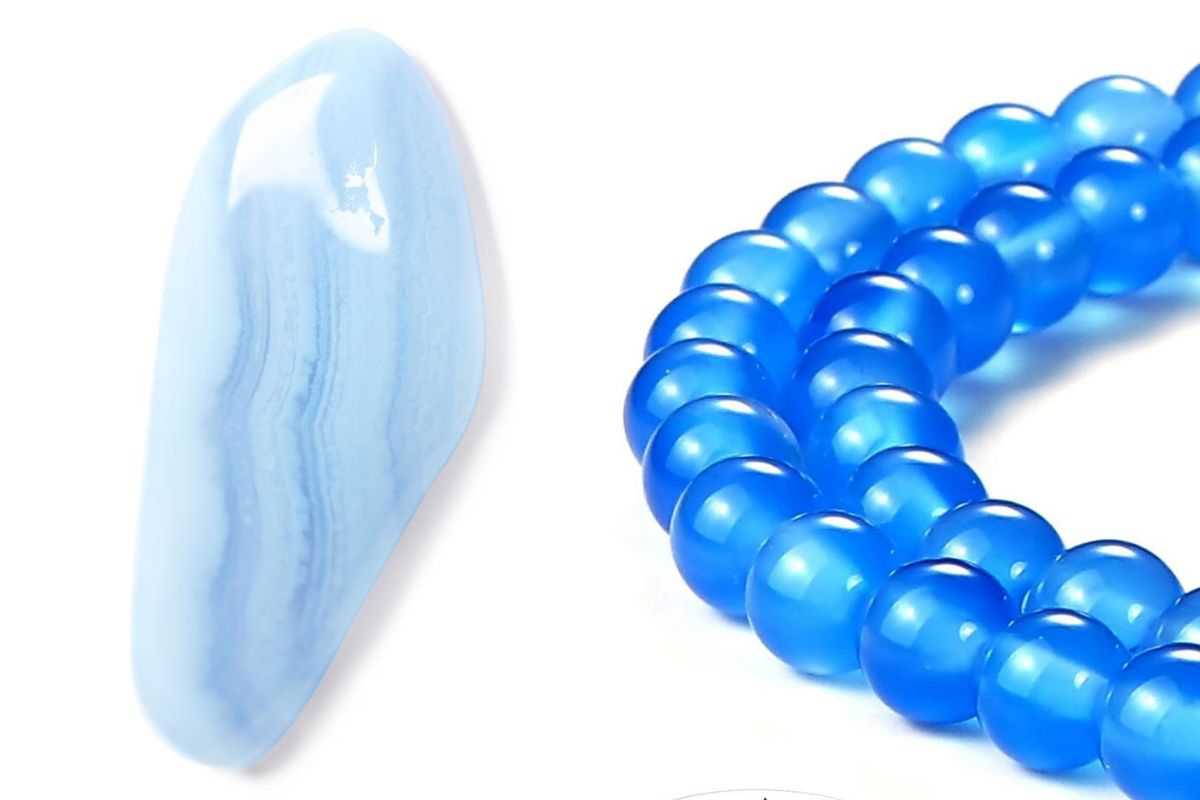Table of Contents
Blue agate vs Blue lace agate
Blue agate and blue lace agate are interchangeable names of the same type of banded chalcedony belonging to the microcrystalline quartz family. The more popular name of blue agate is blue lace agate, which is so-called because of the soft colors (white and different shades of blue) laid out in concentric layers.
The beautiful blues found in this type of agate has made it popular among gem collectors and jewelry enthusiasts. While all banded chalcedony is gorgeous, blue agate stands out because of the softness of its colors and its similarity to the appearance and flow of water.

Blue lace agate
Energy practitioners and those interested in the mystic arts purport that blue agate’s strong resemblance to water makes it a powerful water stone, making it an essential part of any gem collection for energy healing and the like.
A subtype of blue agate is found only in one mining locale: Holley, in the state of Oregon. Because of its rarity and the specificity of where it is mined, this subtype of the blue agate is called “Holley/Holly blue agate.”
Holly blue agate is vastly different from what we have known as the forerunner of the blue agate phenotype. Holly blue agate has a rich and deep blue color instead of having concentric layers with multiple colors. Breaking open a rough Holly blue agate reveals a core with characteristic banding patterns emanating from a single core or center.
The color pattern is radiant, usually with the deepest and most saturated blue emanating from the center. The coloration can begin to change as it moves outward. The colors can start to lighten, or the colors may jump to another part of the spectrum and turn purple, which is closest to the deep blue characteristic in Holly blue agate’s inclusions.
Chalcedony, a type of mineral quartz, is characterized by subtle layers of microcrystalline structures that give rise to beautiful color patterns. The visibility and brightness of the color banding are unique to chalcedony, and the visual effect of the layering is not easily found in other minerals because of how this type of quartz is created. Microcrystalline quartz is formed chiefly by the interaction of water with different elements and volcanic activity. The geological processes allow for the deposition of various factors over millions of years, creating the organic color patterns that we so love.
How is Blue Agate Made?
All agate gemstones share similar origins, but they differ slightly in their chemical compositions. As you may know, minerals get their colors from changes in their chemical structure. Slight variations in the chemical structure can result in changes in color and internal formations, which influence the overall physical appearance of gemstones.
Agates were first mined in ancient Italy. It is said that the first pebble specimens were sighted at the Achetes River, which is located in Sicily. What caught people’s eyes were the banded patterns that make agates look like they have “eyes.” Of course, these “eyes” are the color whorls that emanate from a single point.
Some agates, like blue agate, have soft concentric patterns that create a soothing wave-like visual effect. Other types of agate, like crazy lace agate, have more complex color systems that involve not just gentle bandings of color, but also curved and concentric patterns with sharp angles and zigzags. Take note that the erratic patterns of color are not familiar to all agate types and are limited to only a few examples like the fire agate.
Agates are known for breaking every conceivable rule when it comes to gemstone aesthetics. People who are only used to seeing diamonds, rubies and sapphires will be taken aback as to how agates “break” the rules of how gemstones should look like.
Agates are semi-precious stones, but they look like they are fresh out of a Van Gogh painting because they are colorful. It can be difficult for someone who has never seen agate to appreciate subtypes like the blue agate because they look so different.
The same blue agates are still evaluated using the same principles used in examining other gemstones. Color, clarity, cut, carat, and different vital facets of gems are still applicable to blue lace agate because they are used primarily for jewelry design and ornamentation.
The one real limit of this type of semi-precious stone is the difficulty encountered by jewelry makers when creating mass-market jewelry. Because the colors of blue lace agate and other agates are not consistent per piece of rough stone, it can be difficult to enact a design or line that uses it as the central stone. Regardless of the difficulties, however, blue lace agate continues to capture the hearts of collectors and gemologists around the world because they are rare, and it’s not easy to locate finished jewelry settings made with blue lace agate.
An interesting fact about these exotic agates is that they are not as popular as “classic” gemstones like rubies and sapphires, but this does not diminish their value. Collectors and trained gemologists are aware that many types of agate are even rarer than rubies, so they should not be minimized or ignored in the jewelry world.
The sheer range of colors observable in this family of quartz makes agate an evolving obsession for gem collectors. You don’t know what you are going to find when you start searching for different agates. Blue lace agate is associated with varying months of birth in some cultures, but it is not an official birthstone in the West. Regardless of this fact, you can associate yourself with the gemstone if you want, and partake of its metaphysical and spiritual properties if you wish.
Blue lace agate is hailed as an excellent spiritual stone in its own right, with mystics and spiritual practitioners stating that it can serve as a mood booster and grounding stone that works just as well as other more well-known gemstones.



